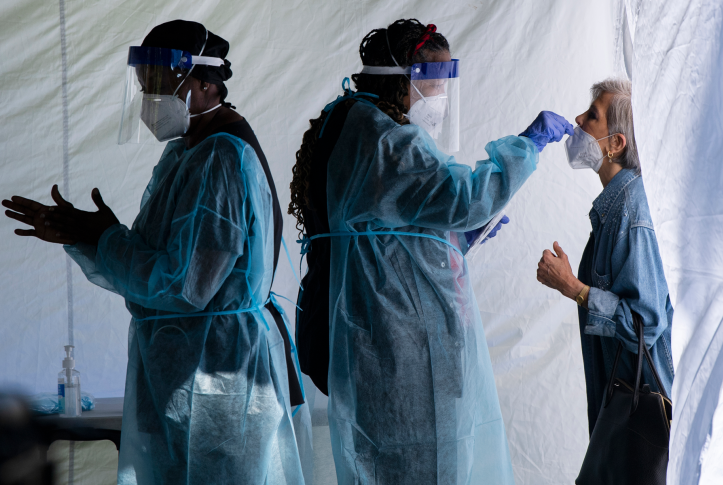The COVID-19 pandemic has underscored the public health and economic vulnerabilities of the United States. As the public health emergency ends, it’s important to reflect on what we’ve learned, consider the persistent risk posed by emerging diseases, and identify steps to mitigate future pandemic threats.
Importance of Sustained Investment in Countermeasures
First, we can learn from the successful aspects of the U.S. response. Emergency appropriations and national coordination yielded the extraordinarily rapid development of both vaccines and therapeutic treatments within a year of identifying SARS-COV-2. Vaccines were distributed rapidly, saving more than 3 million lives and $1 trillion in medical costs over the first two years of the vaccination campaign. At the height of vaccine delivery, more than 3.5 million doses were administered daily. Modeling studies demonstrated that this rapid pace of vaccination likely prevented a deadly surge in summer 2021, and substantially mitigated mortality from the Delta and Omicron variants. As we consider U.S. pandemic preparedness, we must ensure that the funding and coordination mechanisms that enabled COVID-19 vaccine and treatment delivery receive sustained support.
Need for Expanded and Modernized Public Health Infrastructure
The public health workforce in the U.S. has been underfunded for decades. This problem came into stark relief when the need for contact tracing overwhelmed existing personnel. This deficit in our public health system was mirrored in the health care delivery system, where the influx of COVID-19 patients exacerbated preexisting nursing shortages. Clinical staff are the core of the health care system and a critical component to ensuring our ability to prevent and respond quickly to public health threats. The link between inadequate clinical staffing and patient mortality is well established. Consequently, strain on health care system capacity has reverberations for the entire population, not just those experiencing illness. We need to make a substantial investment in training and retaining our medical and public health workforce, so that seemingly excess capacity during routine periods can absorb emergency overflows.
In addition, we urgently need to upgrade our disease surveillance and our data management. In referring to public health data reporting in the U.S. as “puttering along the data superhighway in our Model T Ford,” a 2019 Centers for Disease Control and Prevention report emphasized the need for a core data infrastructure. Unfortunately, the proposed changes did not materialize prior to the COVID-19 pandemic. These calls are now being echoed by an array of experts. Congressional reauthorization of the 2023 Pandemic and All-Hazards Preparedness Act provides an opportunity to establish sustained funding to upgrade public health information technology.
Plan for Socioeconomic Inequities and Racial Disparities, and Allocate Resources Accordingly
The pandemic revealed major fault lines of socioeconomic and racial disparities. Black, Hispanic, and Native American people experienced substantially higher death rates than their white counterparts, even when accounting for differences in age and underlying comorbidities. Racial disparities were evident within the first year of the pandemic and were subsequently exacerbated by differences in vaccine uptake. We must take concrete steps to address racial disparities in health outcomes, including measuring disparities, diversifying the health care workforce, and rebuilding trust between government and communities at risk.
Stockpile Critical Resources
Protecting health care staff from infectious exposure is both a moral imperative and fundamental to a functioning health care system. The U.S. must maintain sufficient stockpiles of personal protective equipment (PPE). Adequate PPE stockpiles would consist of high-quality masks and respirators that protect against droplet and aerosol infection, as well as large quantities of gloves, face shields, gowns, and hand sanitizer. Medical device and PPE supplies are currently maintained by the U.S. Strategic National Stockpile. While its exact magnitude and composition is not publicly known, the stockpile is acknowledged to be underfunded and geared toward bioterrorism, rather than pandemic response. Expansion of funding and sustained focus are critical.
Expand Access to Health Insurance
More than 60,000 of U.S. COVID-19 deaths in the pandemic’s first year were attributable to inadequate health insurance. The exponential growth potential of a pandemic requires a shift in focus from viewing insurance as strictly serving the individual to its larger purpose of protecting a population. Delaying care for an individual with COVID, for instance, leads to more severe outcomes for the patient but also a longer period in which that person can spread disease. A comprehensive paid sick leave policy in the U.S. could have lessened fears about missing work while also reducing the rate of disease spread. A cross-state analysis found that insurance coverage is associated with lower mortality from COVID. The study also found that states with sick leave and family leave experienced better outcomes.
Conclusion
In other sectors, such as defense, we maintain vigilance against threats to American lives, even in the absence of war, and stay nimble to respond to evolving events. Emerging virulent pathogens, while unseen, are no less perilous and require comparable ongoing efforts to ensure the U.S. can swiftly act to protect current and future generations. COVID-19 defied expectations. Our response to future pandemics must support public health and health care practitioners and clearly communicate both the state of current knowledge and the likely possibility of change. We must consider lessons from our past as we make investments and implement policy changes to put the U.S. on a different path.






